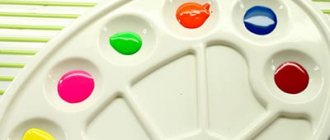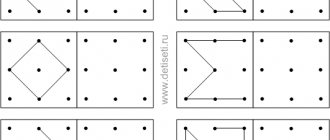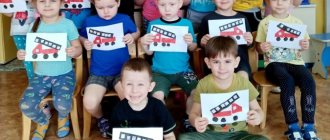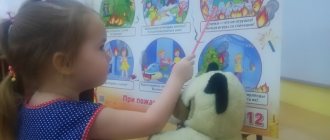Preparatory group. Senior preschool age. Children 6-7 years old
Lesson on financial literacy for children of the preparatory group “Pinocchio and his coins” Goal: to form the prerequisites for cognitive universal educational actions when performing financial logic puzzles and to create motivation for improving the financial literacy of children of senior preschool age. Objectives: Educational: — To consolidate children’s knowledge about…
Synopsis of the integrated educational activity “Travel around the Crimea” for children of senior preschool age Synopsis of an integrated lesson for children of senior preschool age with the priority of patriotic education Topic: “Travel around the Crimea”
Goal: to form children’s idea of their native land; teach children to treat the traditions and heritage of their ancestors with love and respect...
Receptions in classes to prepare for school in kindergarten
When preparing for school, it is very important to introduce children to all possible types of pedagogical interaction, in other words, to teach them to work in conditions where the teacher uses various methodological techniques. In the practice of preschool and school education, 4 groups of methods of interaction with students are used.
Verbal techniques
Since the word plays a key role in the development of a child, verbal methods of interaction with children in the process of educational activities are leading. By listening to the teacher’s speech, as well as entering into dialogue and composing monologues, the children learn to find a common language among their peers. In addition, we must not forget that children 5–7 years old, listening to adults, form their own speech image, which largely determines the successful socialization of preschoolers and future first-graders.
Explanation
This verbal technique accompanies any type of activity of preschoolers. Moreover, even if we are talking about repeated instructions for performing a routine moment (for example, behavior at the table or getting ready for bed), an explanation is still necessary, at least in the form of instructions from simple sentences.
It is worth special mentioning the use of explanation as a motivational technique. Children of senior preschool age try to imitate adults in everything, therefore, for speech development and inclusion in one or another type of activity, verbal techniques traditionally used by the teacher can be left to the pupils. For example, give the task to explain to your comrades the procedure for completing an addition example or the progress of working on a craft.
Conversation
In this format, it is possible to build not only the test of material mastery that is accepted in pedagogical practice. With the help of leading questions on the topic, children can create an algorithm for completing a particular task.
For example, before starting to draw, I talk with my students about the following questions:
- What do you need to paint?
- How should we prepare the workplace?
- Why is it important to organize your work correctly?
This is interesting. It is very important to include “why” questions in the conversation, that is, problematic ones. They teach children to think, analyze, and draw conclusions.
Problematic questions should be included in any dialogue with children.
Riddles and poems
Typically, these techniques are used to motivate children to get them ready to complete a task. But in direct educational activities, riddles can also be used to practice the material studied. For example, having completed the repetition of vowels in class, I invite the children to repeat the material they have learned by solving riddles:
- “Watermelon” and “Almanac” begin with this letter. We all see it in almost all words. (The letter a").
- The goat bleats: “Me” and “me”, He only knows “Em” and ... (“e”).
- The hedgehog dozed off under the tree, Someone robbed the animal: Instead of “Hedgehog” there is only “hedgehog” lying near the tree. Where the maples are near the fishing line, “Yolka” became simply “elka”. Come on? How many of you found out what letter the hedgehog slept through? (Letter “e”).
- The first in the words “Needle”, “Oriole”, “Turkey”, “Caviar”. (Letter “i”).
- “Cloud”, “Glasses”, “Wasp”, “KNIFE”, “pendant” and “sausage”... Children have known for a long time that the letter ... (“o”) is similar to a steering wheel.
Poems can also be used for several purposes:
- remember what you have learned;
- get acquainted with new material;
- repeat acquired knowledge, skills and abilities at home (poems are often used as homework).
With my students when studying the topic “Time. Days of the week" we remember the order of the days of the week along with the rhyme:
- On Monday I did the laundry, and on Tuesday I swept. On Wednesday I baked kalach with honey, and on Thursday I played ball. On Friday I washed the dishes, and on Saturday I bought a cake. On Sunday I rested and read good fairy tales.
Reading
In the preparatory group, most of the children can read, so they can be given the task of reading short passages on the topic. At the same time, it is important that the text as a whole and all the words in it are understandable to the children. Reading can be used as a means of implementing a heuristic approach to education - when children find the information they need on their own. For example, in work on preparing for school, this could be understanding the watering regime for indoor plants.
This is interesting. The older the children become, the less they should read aloud, and the more they should involve themselves in this type of activity. Some psychologists claim that this technique contributes to the rapid development of reading skills.
Reading small information blocks by children stimulates other children to quickly master this important skill.
Fairy tales
I use short story sketches to motivate children, to distract them from their current studies and attract them to a common activity. For example, in order to motivate children to engage in educational activities, I offer my kids a fairy tale about Masha, who was afraid to go to school. “Once upon a time there was a girl Masha. She really wanted to grow up quickly and go to school to learn a lot. Masha thought that school would be very fun, there would be a lot of games and entertainment with friends. However, when Masha went to school, she became very scared, because there were unfamiliar children around, and the teacher explained to everyone that they should behave quietly and calmly. And then there were lessons in which the girl did not succeed, and she was afraid that the teacher would scold her. Masha came home in tears; school turned out to be completely different from what she had dreamed of. The mother explained to her daughter that we are all afraid of the unknown, and everyone can make mistakes, there is nothing wrong with that. The next day Masha went to school again, where she made friends with the guys and learned a lot of new and interesting things.” After the children have listened to the fairy tale, you can check your understanding of the plot using questions: Why did Masha want to go to school? What was Masha afraid of? What did the girl's mother say?
A teacher using fairy tales as a method for motivation must take into account that:
- the plots should not be too long, with a large number of characters (2-3 heroes are enough);
- the development of the action should not be overloaded (that is, 1–2 plot twists are quite enough);
- fairy tales must be accompanied by visual aids (pictures or toys from whose perspective the story is told).
Plot sketches should not be long, otherwise preschoolers may lose interest in further activities.
Visual techniques
Children perceive most information from the world around them through the visual channel. Therefore, visual techniques are actively used in preparation for school. Among the most effective are:
- pictures (illustrations accompany not only plot narratives, for example, fairy tales, but also routine moments, for example, the order of folding clothes in the closet after a walk);
- diagrams (this type of clarity is very important for mastering the skill of writing, since in the diagrams kids see the sequence of writing out the elements of letters);
- display (the best way to make children feel involved in a particular activity is to show that an adult is also passionate about it, for example, by completing an application on the topic “Types of transport. Airplane”, the teacher and children can arrange a competition to see who can come up with the most realistic or similar per sample model);
- demonstration (video materials can be used productively when developing topics in mathematics, speech development, and literacy).
Video: learning to add and subtract within nine
Practical techniques
To consolidate the studied material, practical techniques are traditionally used that demonstrate creative comprehension of information:
- drawings;
- applications;
- crafts.
These types of work can be united by a common task - creating a project on the topic. For example, “I am a future first-grader.”
Photo gallery: examples of drawings on the topic “I am a future first-grader”
In the drawings, children depict not only the school building, but also their future image of a first-grader
In drawings, preschoolers express their expectations from school
In the projects, children demonstrate their vision of the image of the school
Parents participate in the creation of the project, providing mediocre assistance, for example, designing inscriptions
Observation
The use of this practical technique is important for the development of a heuristic way of acquiring knowledge by children. That is, the guys themselves obtain information, analyze it and, in connection with this, formulate certain conclusions. The function of the teacher in this case is limited to helping in generalizing and systematizing the material. Observation is organized during a walk or in the form of experiments in a group.
Table: file of observations in preparation for school (fragment)
| Subject | Target | Description |
| Monitoring air temperature changes |
| Children record air temperature in August and September. They come to the conclusion that the first month of autumn is colder than the last month of summer by an average of 5 degrees. |
| Observing the snow melting process |
| Children observe the speed of snow melting and determine that it melts faster near tree trunks, as the roots absorb water. |
| Tree watching |
| Children watch the trees in the area, where sap is released from cracks in the bark - a delicacy for insects. Based on the existing knowledge about the movement of water along the trunk, the guys come to the conclusion that under the influence of spring heat, water with useful substances from the ground moves along the trunk to the branches and buds, from which leaves will soon appear. |
Gaming techniques
Game techniques are actively used in preparing for school, since play is the leading activity of preschoolers.
Didactic games
This type of games is actively used when organizing GCD, since it allows:
- get acquainted with new information;
- practice and consolidate acquired knowledge, skills and abilities;
- repeat the studied material.
There are 2 types of educational (didactic) games:
- content-oriented game actions;
- based on game material.
Didactic games based on game material cultivate perseverance in preschoolers
Table: types of didactic games in preparation for school
| Type | Type of game | Name | Goals | Description |
| Content driven games | Logical | "Flowers in the Flowerbeds" |
| The teacher distributes paper flower beds of round, rectangular and square shapes to the children. Gives out 3 different colored flowers. Children arrange flowers, focusing on the story: “The red flowers did not grow in a square, but not in a round flowerbed. And the orange ones are not on the round one, but not on the rectangular one either. Plant the flowers correctly." |
| Verbal | “I - for you, you - for me” |
| The teacher pronounces the sentence, the children count the number of words in it. Whoever answered quickly and correctly wins and says his sentence, the words of which are counted by the rest of the participants. | |
| Sensory | "Name it in parts" | Practice the skill of composing an image from parts and, conversely, decomposing the whole into parts. | Children put together pictures from individual parts (for example, wheels, body, cab - truck). Then they talk about the purpose of each element. | |
| Musical | "Guess what it sounds like" |
| The teacher plays a musical instrument behind a screen, and the children guess what it sounds like. | |
| Material-oriented games | Desktop-printed | "Seasons" |
| Children quickly group pictures with the names of months, signs of seasonal changes, and then compose a coherent story about the seasons. |
| Playing with objects | These are mainly games with natural materials. For example, count the number of acorns for a squirrel and a hedgehog, distribute equally, give one of the characters more, etc. | |||
| Interactive | These games use computer technology. So, in math classes to prepare for school, children can be offered the game “Masha and the Bear”, in which children, together with the characters of their favorite cartoon, complete addition and subtraction tasks. | |||
Outdoor games
Health-saving teaching methods are the main ones in working with preschool children. For their practical implementation, outdoor games are actively introduced into all elements of the educational process, which also fulfill the task of maintaining the general emotional tone in the group.
Outdoor games lift the spirits of both children and adults
Table: types of outdoor games used in school preparation classes
| Skill to be practiced | Name of the game | Goals | Progress of the game |
| Running in different directions, jumping | "Blind Man's Bluff" |
| Children stand in a circle, one participant is blindfolded. He turns around himself several times. Then the participants scatter, and the trap, with its eyes closed, tries to catch one of them, focusing on steps or other sounds. |
| Spatial orientation | "Trap with Ribbons" |
| Children stand in a circle, each with a ribbon under their belt. At the signal, the participants scatter, and the trap tries to snatch the ribbon. According to a conventional sign, the children stop, and the trap counts the number of players caught. |
| Forming a sense of balance | "Fishing rod" | Learn to jump over a rotating rope. | The driver throws a jump rope across the floor, the rest of the participants must jump over it, maintaining their balance. |
| Ability to imitate | "Ocean is shaking" |
| Children stand in designated circles and perform any movements. The driver walks between the players, periodically puts his hand on the participant’s shoulder and, at the signal “The sea is rough,” performs a movement that the player must repeat. At the same time, the driver takes the player away from the circle. At the signal “The sea is calm,” the participant must run to his circle. If he doesn’t have time, he becomes the driver. |
| Development of attention | "Be careful" |
| Children stand in a line, with several objects in front of them at a certain distance: cubes, skittles, flags, etc. At the driver’s signal, the participants run to the objects and halfway along they hear an indication of which one they need to take. The one who correctly followed the instructions wins. |
| Practicing climbing and crawling skills | "With the ball under the arc" |
| Children take turns crawling under arches about 40 cm high, while pushing a medicine ball with their heads. The number of arcs is determined by the area of the space. |
| Agility training | "The Kite and the Mother Hen" |
| Children stand in a column, the first participant is the hen, the rest are chickens. According to a conventional sign, a “kite” flies out of the nest and tries to grab the chick standing last in the column. The hen runs away with the rest of the participants, turning so as to protect the “chicken”. The column cannot be disengaged. |
Theatrical games group
When preparing for school, several types of theatrical games are included in the educational process:
- role-playing games, in which children, based on personal experience, act out everyday situations (at a doctor’s appointment, in a lesson at school, etc.);
- dramatization, where children perform play actions based on the instructions of the “director,” that is, a teacher or friend (for example, skits based on read fairy tales, participation in thematic matinees, etc.);
- director's games, that is, performing game actions based on an invented plot (for example, acting out saving hares from a flood in the forest on a flannelgraph);
- finger games are exercises for training fine motor skills aimed at activating speech centers.
By playing out various situations and fairy tales, preschoolers learn new behavior patterns, become more independent and self-confident.
By playing school, children in a safe environment become familiar with the roles of students and teachers.




